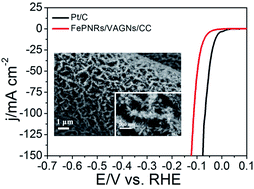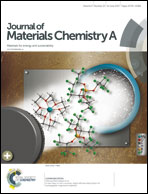A 3D-composite structure of FeP nanorods supported by vertically aligned graphene for the high-performance hydrogen evolution reaction†
Abstract
Iron phosphide (FeP), as a low-cost and earth-abundant electrocatalyst, has received increasing attention in recent years. However, its hydrogen evolution reaction (HER) performance is still far from satisfactory in terms of both activity and stability. In this study, by employing vertically aligned graphene nanosheets (VAGNs) as the backbone, we synthesized a novel three dimensional (3D) FeP/VAGN hybrid nanostructure on carbon cloth (FePNRs/VAGNs/CC) as a binder-free efficient electrocatalyst for the HER. The villiform FeP nanorods with diameters of ∼50 nm and lengths of 100–300 nm were successfully grown on the surface of VAGNs by an electrodeposition process followed by a phosphidation treatment. The separate VAGNs not only provide a 3D architecture for FeP growth, but also facilitate charge transfer. As expected, this 3D hybrid electrocatalyst exhibits an enhanced HER activity with an onset potential of 19 mV, an overpotential of 53 mV at 10 mA cm−2, a Tafel slope of 42 mV dec−1, and a remarkable stability and durability in an acid solution. The superior hybrid FeP electrode might pave an efficient way for the practical application toward hydrogen generation.



 Please wait while we load your content...
Please wait while we load your content...